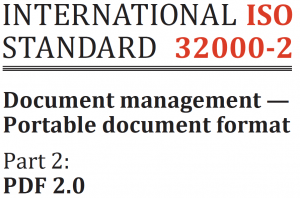
PDF 2.0: The worldwide standard for electronic documents has evolved
The Portable Document Format is perhaps the most common example of a de facto standard, so much so that Wikipedia features PDF on its “de facto standards” page. From Ethernet and 802.11 to HTTP and CSS, the modern computing stack consists of hundreds of standards. The way in which PDF exemplifies the specific value of standards is almost unique, for PDF’s value proposition – the reason why PDF is today’s worldwide de facto standard for electronic documents – is the fact of standardization itself … Read more
 The Portable Document Format is perhaps the most common example of a de facto standard, so much so that Wikipedia features PDF on its "de facto standards" page.
The Portable Document Format is perhaps the most common example of a de facto standard, so much so that Wikipedia features PDF on its "de facto standards" page.
From Ethernet and 802.11 to HTTP and CSS, the modern computing stack consists of hundreds of standards. The way in which PDF exemplifies the specific value of standards is almost unique, for PDF’s value proposition – the reason why PDF is today’s worldwide de facto standard for electronic documents – is the fact of standardization itself.
While exceptions are possible, PDF files are, in principle, entirely self-contained and fully interoperable, working equally well with standards-conforming PDF software from every vendor. End-users should be able to gain equivalent results irrespective of their choice of software.
This core capability – the fact that PDF technology makes it possible for different software to have the same results – is the key to the technology’s success.
Invented by Adobe Systems and first released in 1993, Adobe’s PDF version 1.7 became ISO 32000-1 in 2008. Since then, over 40 members of ISO TC 171 SC 2 WG 8 from 20 countries have contributed to development of the PDF specification.
PDF's existing features (wow!)
It didn't take PDF 2.0 to make PDF one of the most powerful and flexible formats ever invented. Just some of PDF's capabilities (most are almost 20 years old!) include:
- (as noted above) preservation of document fidelity independent of the device, platform, and software
- merging content from diverse sources — web sites, word-processors, spreadsheets, scans, photos and graphics — into a single self-contained document while maintaining the integrity of all original sources
- an extensible metadata model at the document and object level
- collaborative editing of documents from multiple locations or platforms
- digital signatures to certify authenticity
- security and permissions to allow the creator to retain control of the document and associated rights
- accessibility of content to those with disabilities
- extraction and reuse of content for use with other file formats and applications
- electronic forms to gather and/or represent data within business systems.
 "PDF 2.0 continues the evolution of the world's preeminent portable document format, containing key updates while expanding upon PDF's strengths. PDF 2.0 enhances the vitality and capability of the entire document ecosystem - handling the needs of users today and into the future. This does not represent the end of the journey, however: PDF will continue to evolve to meet the needs of the future, just as it has since its creation nearly a quarter century ago."Matt Kuznicki CTO, Datalogics & Chairman, PDF Association
"PDF 2.0 continues the evolution of the world's preeminent portable document format, containing key updates while expanding upon PDF's strengths. PDF 2.0 enhances the vitality and capability of the entire document ecosystem - handling the needs of users today and into the future. This does not represent the end of the journey, however: PDF will continue to evolve to meet the needs of the future, just as it has since its creation nearly a quarter century ago."Matt Kuznicki CTO, Datalogics & Chairman, PDF Association "Today PDF is so easy to use that it perceived as absolutely given. People often forget that it actually is a technology that's more than 20 years old - eons in the IT world. The great thing in PDF 2.0 is that it renovates almost every part of PDF without removing or significantly changing any of its features and USPs. Its many clarifications and modifications are a translation of all the experiences that the community has made during these 20 years."Dietrich von Seggern Managing Director, callas software & & Vice Chairman, PDF Association
"Today PDF is so easy to use that it perceived as absolutely given. People often forget that it actually is a technology that's more than 20 years old - eons in the IT world. The great thing in PDF 2.0 is that it renovates almost every part of PDF without removing or significantly changing any of its features and USPs. Its many clarifications and modifications are a translation of all the experiences that the community has made during these 20 years."Dietrich von Seggern Managing Director, callas software & & Vice Chairman, PDF Association "PDF 2.0 is a big step in the evolution of the PDF technology. It is a great result of the combined effort of leading specialists in the field. Notable updates of the security model and logical structure bring PDF up to date with the constantly changing digital world." Boris Doubrov CEO, Dual Lab
"PDF 2.0 is a big step in the evolution of the PDF technology. It is a great result of the combined effort of leading specialists in the field. Notable updates of the security model and logical structure bring PDF up to date with the constantly changing digital world." Boris Doubrov CEO, Dual Lab "We are really glad to see the PDF 2.0 effort finally coming to fruition. It is a major step in the evolution of PDF being an open and independent standard. We at Foxit are really excited about the opportunity to provide PDF 2.0 compliant suite of software to the market, and strive to be early and best among the group of PDF vendors. We are particularly excited about some of the new features that further improves the usefulness of PDF documents, and look forward to their wide adoption."Steven Li CTO, Foxit
"We are really glad to see the PDF 2.0 effort finally coming to fruition. It is a major step in the evolution of PDF being an open and independent standard. We at Foxit are really excited about the opportunity to provide PDF 2.0 compliant suite of software to the market, and strive to be early and best among the group of PDF vendors. We are particularly excited about some of the new features that further improves the usefulness of PDF documents, and look forward to their wide adoption."Steven Li CTO, Foxit "Nitro is delighted to recognise the publication of the PDF 2.0 standard. This will be a watershed moment for digital documents: everyone can now benefit from an internationally recognised, truly open standard. This is a big deal for those of us interested in digital transformation. We look forward to supporting the new standard." Justin Durkan Director of Desktop Engineering, Nitro
"Nitro is delighted to recognise the publication of the PDF 2.0 standard. This will be a watershed moment for digital documents: everyone can now benefit from an internationally recognised, truly open standard. This is a big deal for those of us interested in digital transformation. We look forward to supporting the new standard." Justin Durkan Director of Desktop Engineering, Nitro "As an active member of the ISO working group that developed PDF 2.0, Adobe is excited that see it finally reach publication. These last 8 years of discussion and debate amongst experts from around the world have led to what we believe is the most approachable version of the PDF standard to date." Leonard Rosenthol PDF Architect, Adobe Systems
"As an active member of the ISO working group that developed PDF 2.0, Adobe is excited that see it finally reach publication. These last 8 years of discussion and debate amongst experts from around the world have led to what we believe is the most approachable version of the PDF standard to date." Leonard Rosenthol PDF Architect, Adobe SystemsWhat's changed?
In PDF 2.0, the fundamentals of PDF remain the same, so much so that perhaps the most important enhancement is also the most subtle. PDF 2.0 addresses ambiguities, corrects errors and updates normative references. Hundreds of other pages were touched; some a little, some a lot. Although these changes don't represent new features per se, they make it much easier to implement the specification. In short, PDF 2.0 will make it easier and less costly for developers to improve their support for PDF technology at every level.
New features!
PDF 2.0 includes many entirely new features in addition to the improvements to the existing specification:
- Unencrypted wrapper documents allow secured PDF files to be delivered inside a readable “cover letter” document.
- There’s new support for rich media annotations, geospatial features and PRC, a 3D format.
- Associated files, first introduced with PDF/A-3, now extends to any PDF 2.0 document the ability to include machine-readable metadata about files attached to the PDF. Users gain from an enhanced ability to include source, data and other file-formats as part of their PDF document.
- The clause on tagged PDF, 14.8, has been completely overhauled with a revised tag set, support for namespaces, MathML support and pronunciation hints. The result will be more accessible documents that are also much easier to repurpose for text-extraction, conversion to HTML for small devices, and more.
- Digital signature features have been updated to meet the latest specifications, allowing users new options for verifying digitally-signed PDF documents.
- PDF now supports 256-bit AES encryption, a current-generation standard.
Enhancements to existing features
PDF 2.0 includes significant enhancements to existing features. This list is only the highlights...
- Transparency and blend mode attributes for annotations
- Polygon/Polyline real paths
- 256-bit AES encryption (added to PDF 2.0)
- ECC-based certificates
- Unicode-based passwords
- Document requirement extensions
- Page-level and Referenced (external) OutputIntents
- Thumbnails for embedded files
- Measurement & Point Data for image & form XObjects
- Viewer preferences enforcement (of print scaling)
- GoToDp and RichMediaExecute actions
- Extension to GoTo and GoToR to support linking to a specific structure element
- Extension to Signature Field Locks and Signature Seed Values
- 3D measurements, and extensions to 3D viewing conditions, incl. transparency
- Several new structure elements, including Aside, DocumentFragment, Hn (where n > 6), Title, FENote, Sub, Em, Strong and Artifact structure elements
- Extensions to OutputIntents (MixingHints and SpectralData)
Completely rewritten clauses
Six critical clauses totaling 14% of the 972 page specification were entirely rewritten for clarity and consistency. In some cases, especially transparency, tagged PDF and repurposing, the specification was also substantially enhanced. The areas that were completely rewritten are:
- 7.4.7 "JBIG2Decode filter"
- 10.1 – 10.3, "Rendering"
- 11, "Transparency"
- 12.8, "Digital signatures"
- 14.3, "Metadata"
- 14.8, "Tagged PDF"
- 14.9, "Repurposing and accessibility support"
Deprecations
ISO 32000-2 is the first PDF specification developed entirely within the ISO guidelines and process. It supports non-proprietary technologies and ensures a level playing-field for software vendors that create, display, edit or otherwise process PDF electronic documents. In addition, as features were modernized, the ISO committee elected to deprecate obsolete aspects to reduce the burden on implementers. Deprecated items include:
- XFA (incl. NeedsRendering)
- Movie, Sound and TrapNet annotations (replaced by RichMedia annotations)
- Movie and Sound actions (replaced by RichMedia actions)
- Info dictionary
- Assistive technology restrictions via DRM
- ProcSet
- OS-specific file specifications and additions to Launch actions
- Names for XObjects and Fonts
- Arrays of Blend Modes
- Alternate Presentations
- Open prepress interface (OPI)
- CharSet (For Type 1 fonts)
- CIDSet (for CID fonts)
- Prepress viewer preferences (ViewArea, ViewClip, etc.)
- NeedAppearances
- adbe.pkcs7.sha1 and adbe.x509.rsa_sha1
- Encryption of FDF files
- Suspects flag in MarkInfo dictionary
- UR signatures
In sum
Nine years in development, PDF 2.0 is both an evolutionary and revolutionary specification.
- Evolutionary, because at one level, PDF 2.0 carefully advances PDF's core purpose with better documentation and fewer ambiguities
- Revolutionary, because PDF 2.0 will usher in a wave of PDF-related capabilities such as advanced repurposing and accessibility, 3D models, the latest digital signature technology, embedded files and more... all in the same package.
As such, in addition to staying true to PDF’s core values, PDF 2.0 extends and strengthens PDF's already solid foundation for new use-cases, capabilities and workflows. It's time for PDF 2.0.




